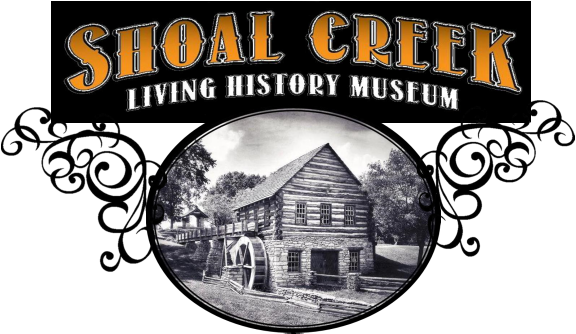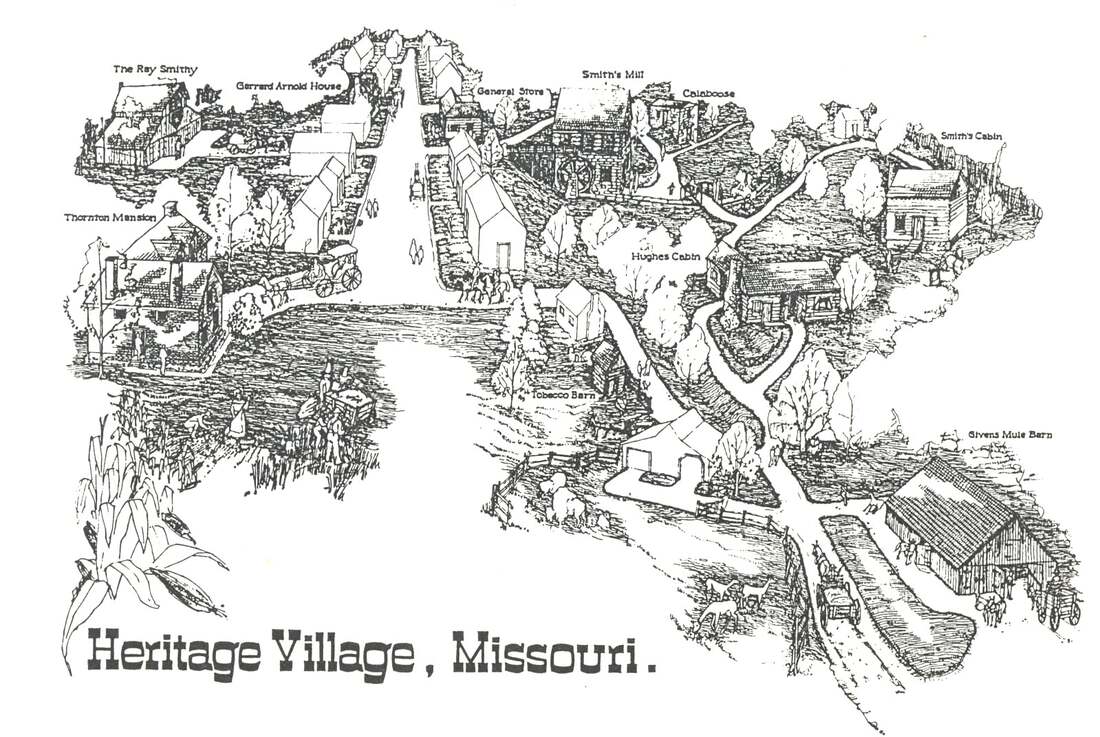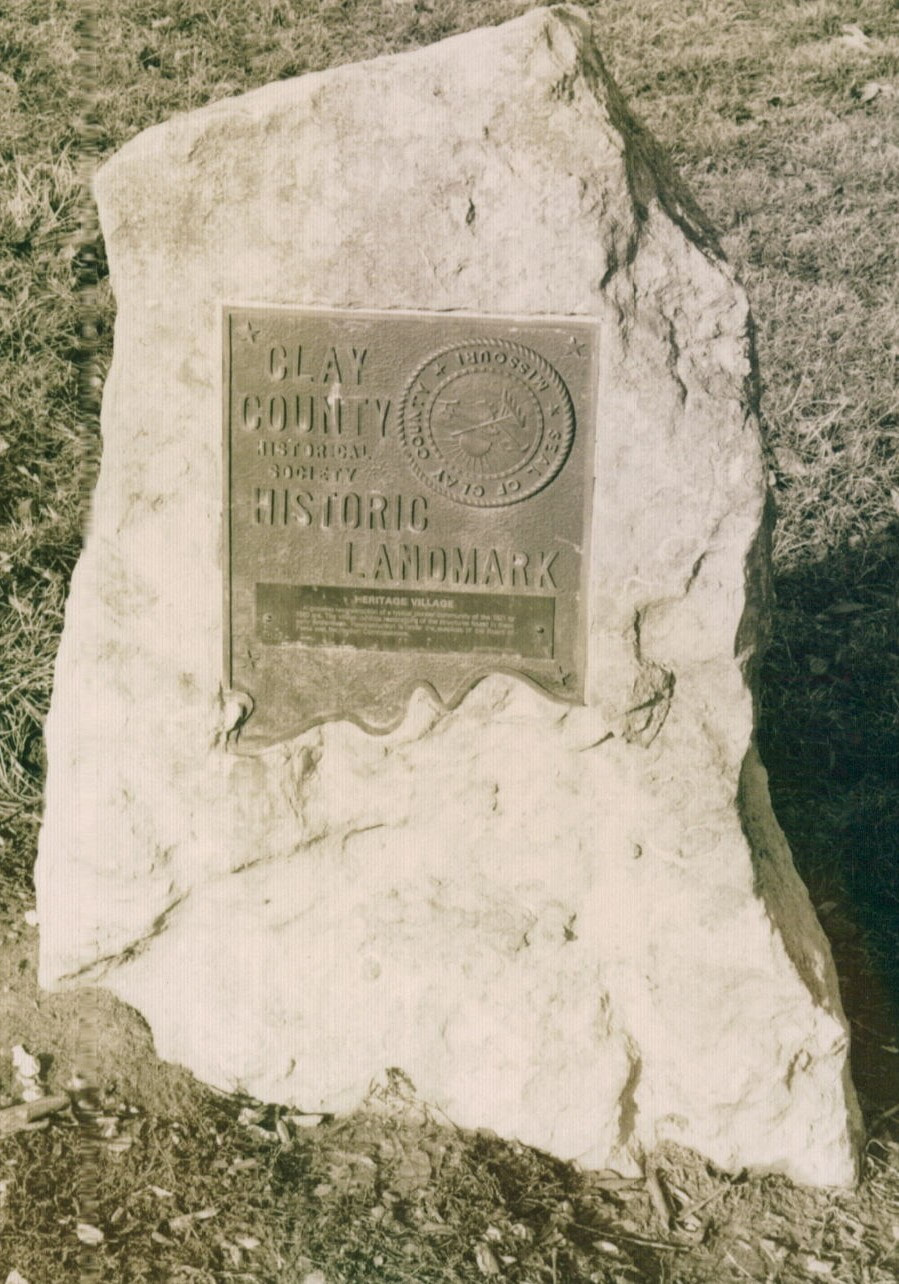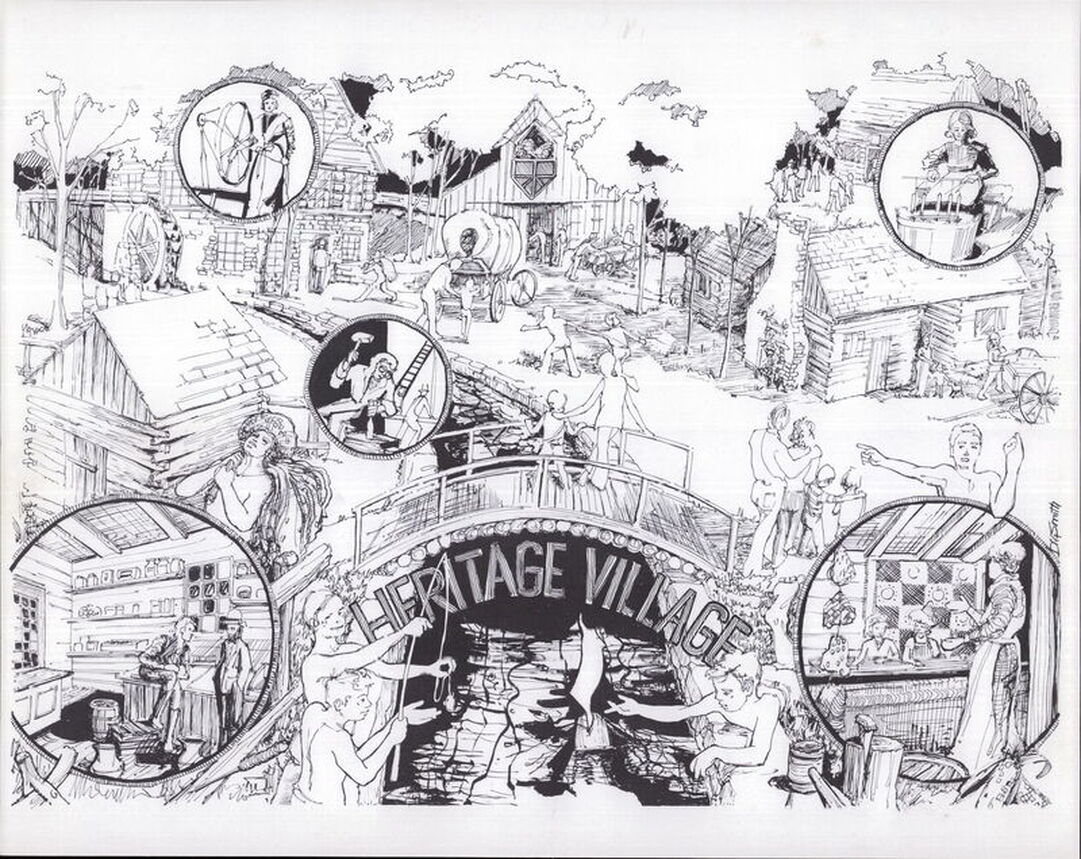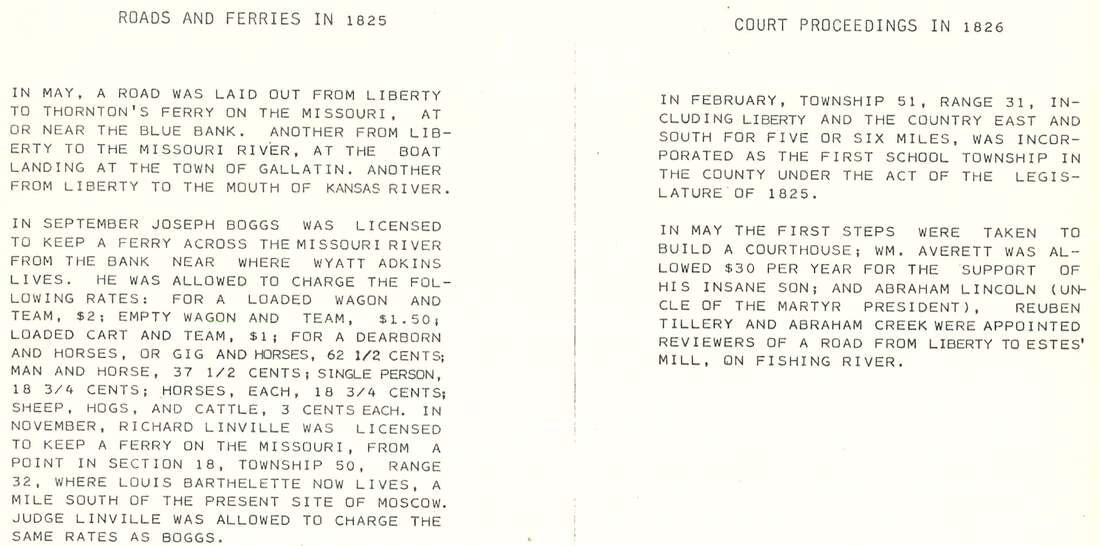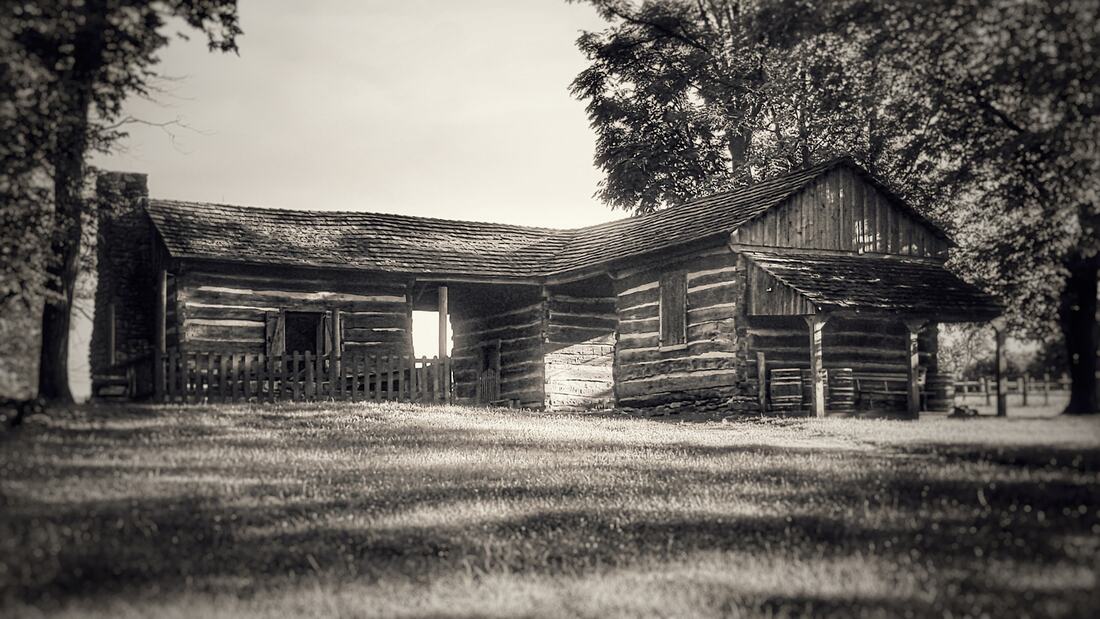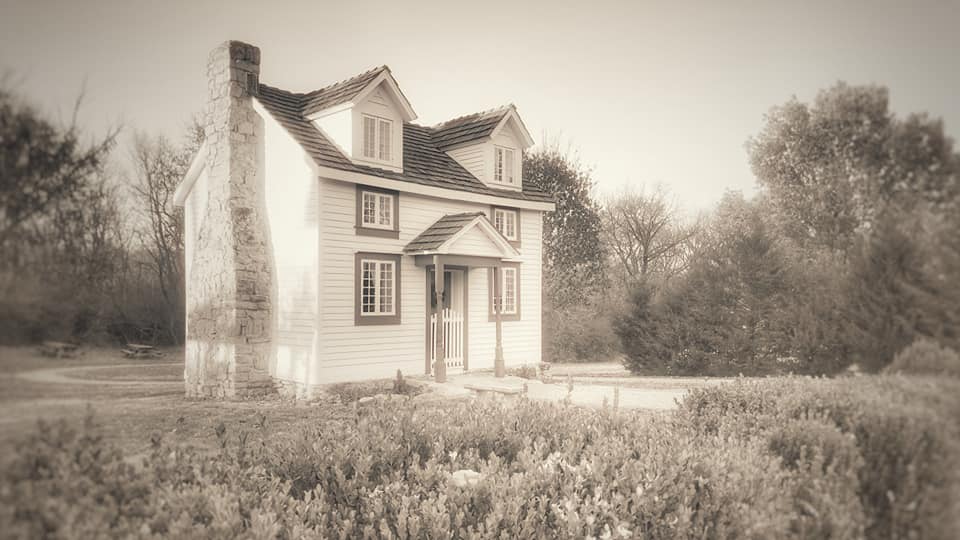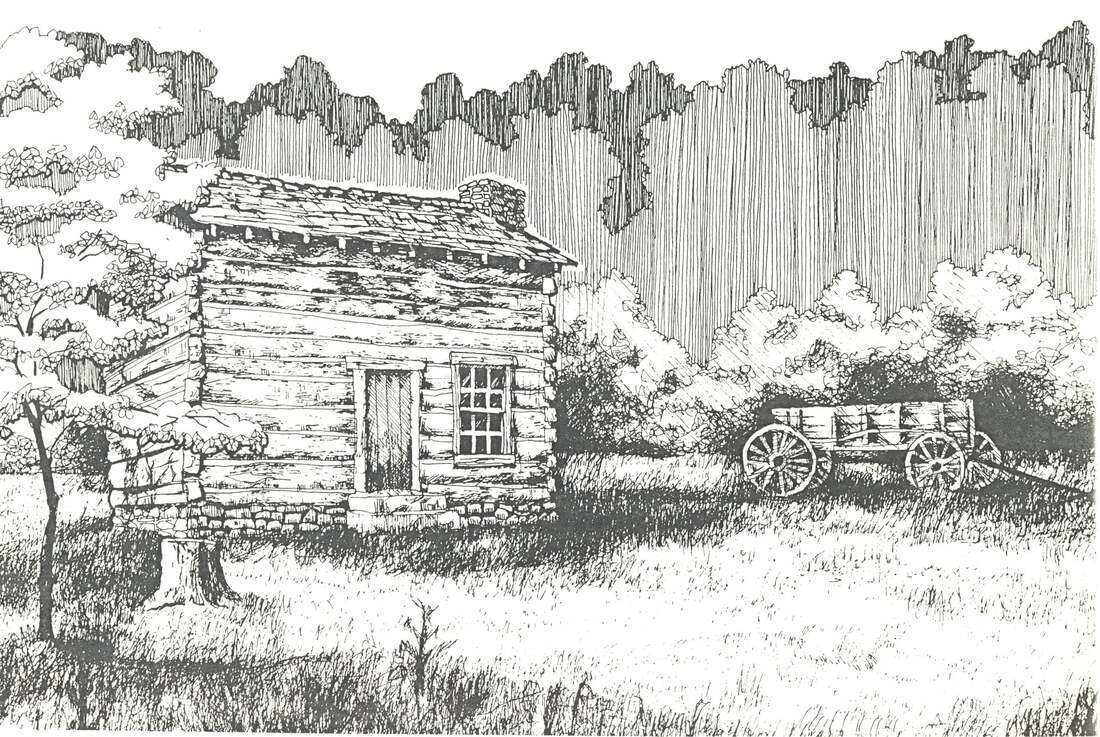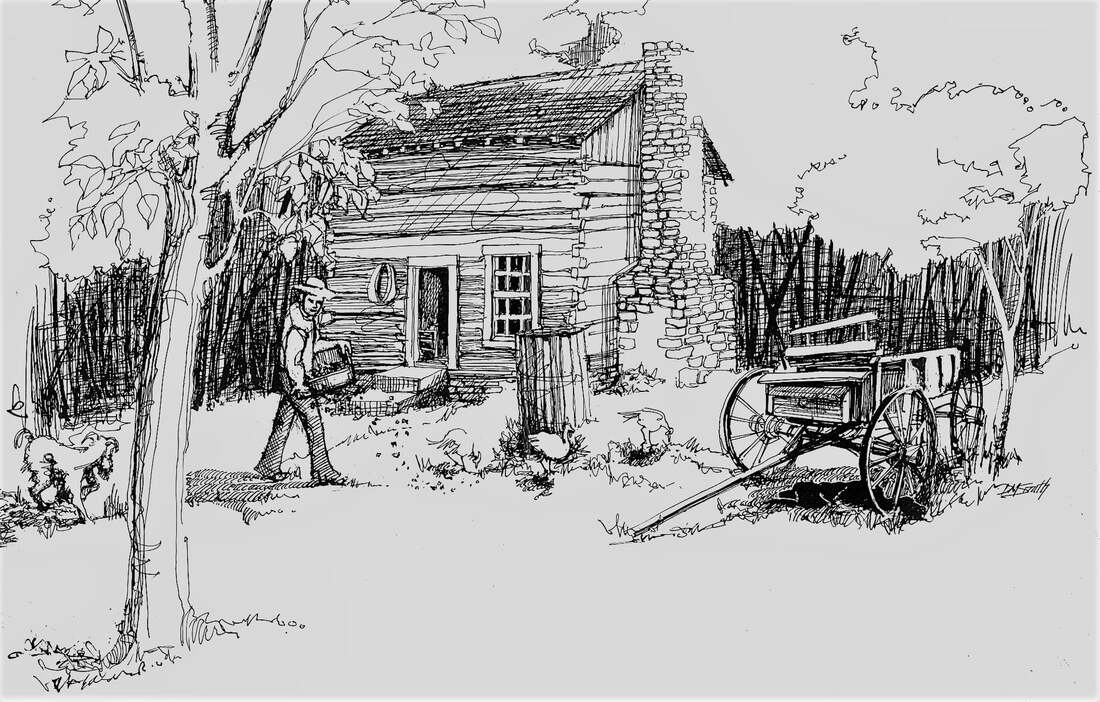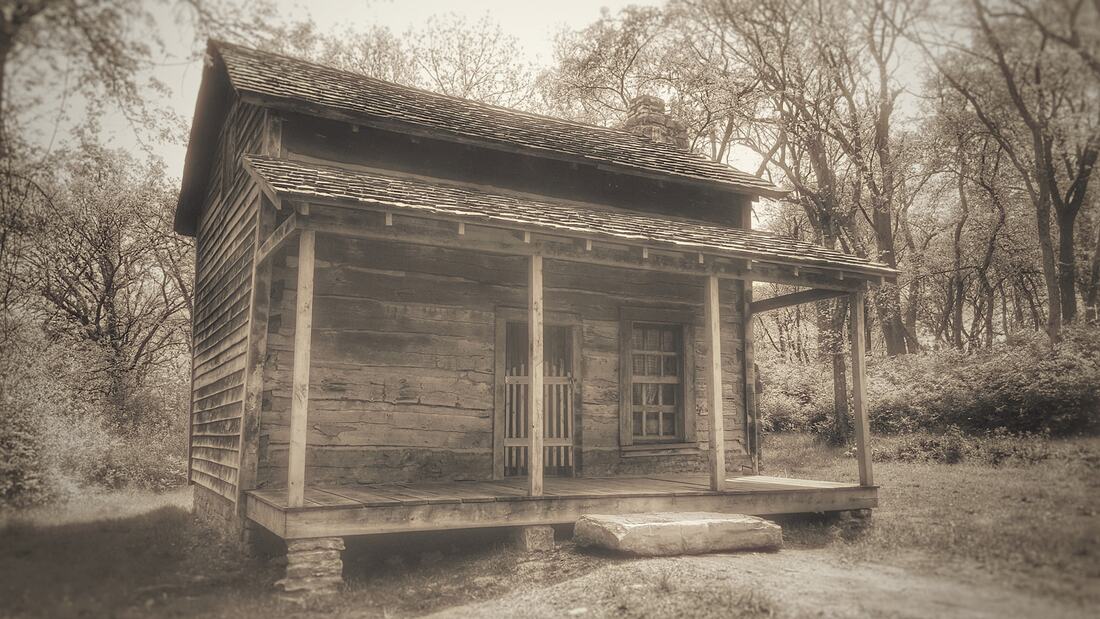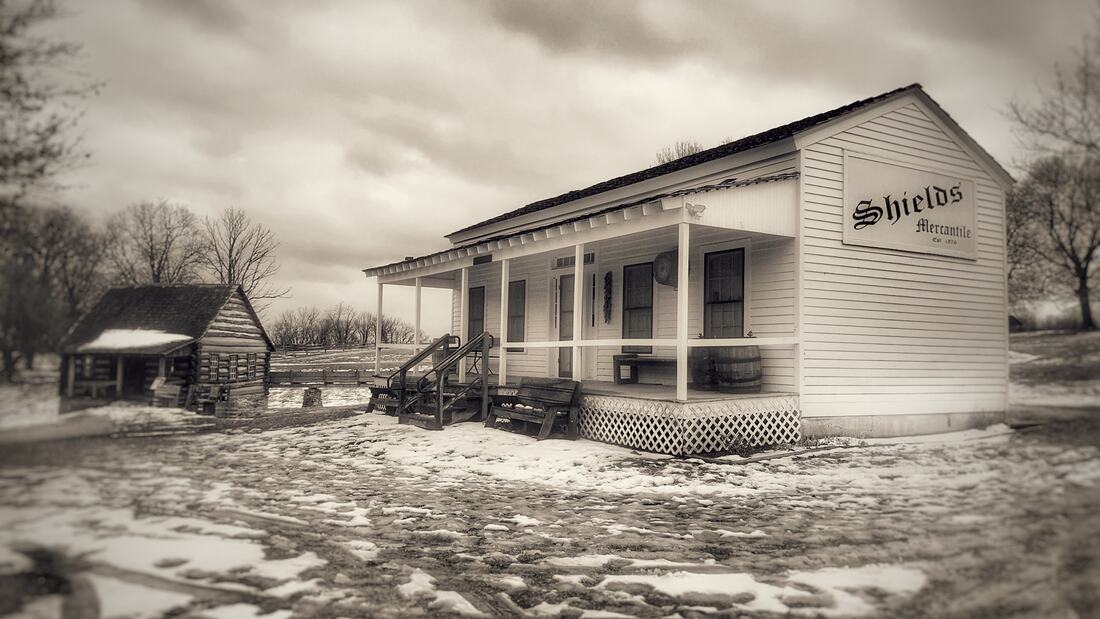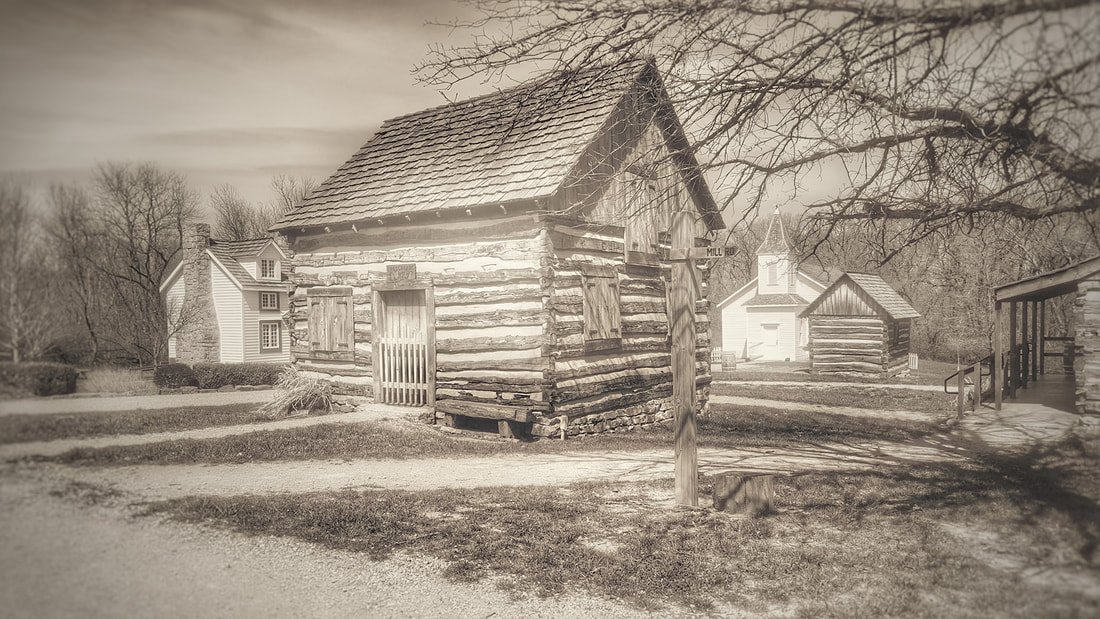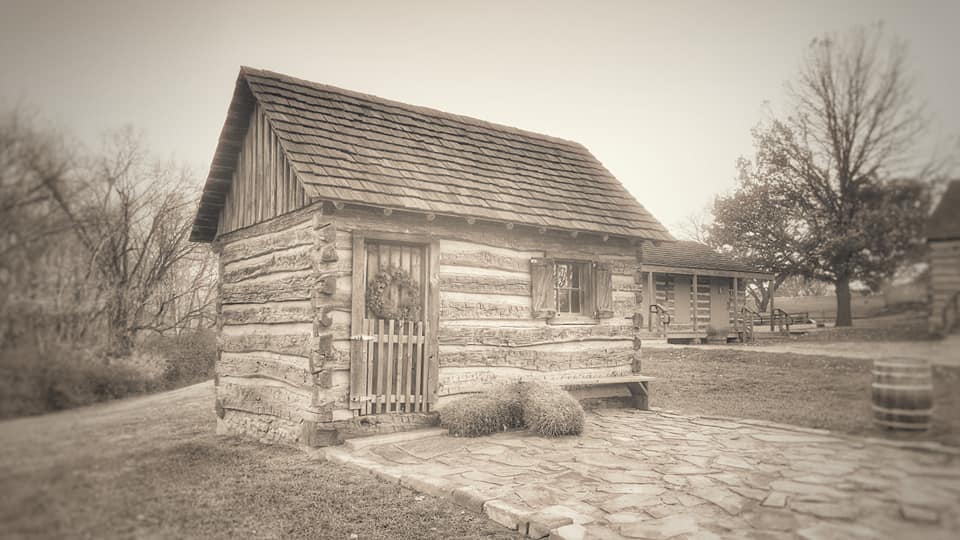Grist Mill 1824 - Shoal Creek Living History Museum
The only structure built on site and is a reproduction of an 1824 mill built by Humphrey Smith along the Platte River near the town of Smithville, Missouri, in Clay County.
The only structure built on site and is a reproduction of an 1824 mill built by Humphrey Smith along the Platte River near the town of Smithville, Missouri, in Clay County.
Daniel W. Hughes Cabin 1825 - Shoal Creek Living History Museum
The Daniel W. Hughes Cabin was built in 1825. A double dog-trot consisting of three cabins connected by a breezeway or "dogtrot" all under a common roof. Each cabin had a different purpose. The oldest of the cabins is know as the Cooking Cabin. The last two cabins were constructed about 1830. Daniel Hughes was born in 1799 at Bourbon County, Kentucky. He was in Missouri by 1825 when he was married to Elizabeth Woods in Cooper County. We know the year he was in Clay County as it is recorded that his son, George Hughes was born here. Daniel and Elizabeth had 10 children.
The Daniel W. Hughes Cabin was built in 1825. A double dog-trot consisting of three cabins connected by a breezeway or "dogtrot" all under a common roof. Each cabin had a different purpose. The oldest of the cabins is know as the Cooking Cabin. The last two cabins were constructed about 1830. Daniel Hughes was born in 1799 at Bourbon County, Kentucky. He was in Missouri by 1825 when he was married to Elizabeth Woods in Cooper County. We know the year he was in Clay County as it is recorded that his son, George Hughes was born here. Daniel and Elizabeth had 10 children.
Col. John Thornton Mansion 1820s - Shoal Creek Living History Museum
John was born December 24th, 1786 in Lancaster County, Pennsylvania. He emigrated to Missouri by 1817. He constructed this home sometime before 1820. He is known to have said that he has lived in three counties without moving his house.
County Judge
Court held in this house and also John Owens up to 1828
Leader in the Democratic party
1832 State Legislature
Colonel who commanded the 28th Regiment, 3rd Brigade, 1st Division, Missouri.
Speaker of the House in 1828 and 1830.
Col. Thornton died in 1847 and Mrs. Thornton in 1857
John was born December 24th, 1786 in Lancaster County, Pennsylvania. He emigrated to Missouri by 1817. He constructed this home sometime before 1820. He is known to have said that he has lived in three counties without moving his house.
County Judge
Court held in this house and also John Owens up to 1828
Leader in the Democratic party
1832 State Legislature
Colonel who commanded the 28th Regiment, 3rd Brigade, 1st Division, Missouri.
Speaker of the House in 1828 and 1830.
Col. Thornton died in 1847 and Mrs. Thornton in 1857
Mt. Ararat Baptist Church 1884 - Shoal Creek Living History Museum
Built in 1884 near Fayette, Missouri, and used until 1985 when it was moved to Shoal Creek. It stands as a proud monument to those early settlers of Howard County. Mt. Ararat Church was started in 1832 as the "Old School Baptist Church" holding its meetings in the old Pemberton School near Fayette, Howard County Missouri. After a fire destroyed the school, a new church building was built and given the name of Mt. Ararat Baptist Church.
Built in 1884 near Fayette, Missouri, and used until 1985 when it was moved to Shoal Creek. It stands as a proud monument to those early settlers of Howard County. Mt. Ararat Church was started in 1832 as the "Old School Baptist Church" holding its meetings in the old Pemberton School near Fayette, Howard County Missouri. After a fire destroyed the school, a new church building was built and given the name of Mt. Ararat Baptist Church.
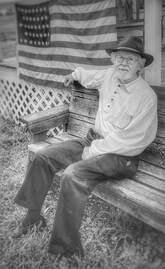
Mt. Ararat Baptist Church, Shoal Creek Living History Museum Kansas City, Missouri
Originally Located in Howard County, Missouri
(A short story of History and Love by Gene T. Waters)
History: 200 years ago settlers from Kentucky and Tennessee and as far away as Delaware come to central Missouri and settled in Howard County, Missouri. The county was the mother of many counties, as there were some 30 counties cut from it. The congregation that became Mt. Ararat was organized in c. 1830 and met under trees and in homes initially. They combined with the Pemberton School and soon became known as the Old Schoolhouse Baptist Church. The School and the church was located 6 miles east of Armstrong, 5 miles south west of Higbee, and about 10 miles north east of Fayette on what is now highway H. A pastor Bro. Terrill, called on the church monthly in his rounds of the area. In 1865 they joined the Southern Baptist denomination. Sometime in the 1870’s the school burned down. They planned a formal church building which they named Mt. Ararat Baptist Church. The building was completed and dedicated on Christmas Day 1884. The church was the social center for the community. There was no electricity, running water, automobiles, radios, or airplanes. On Sundays the church family socialized at the church for the day, then went home for another wee. Baptisms took place in the local pond.
The Church steeple is topped by a fleur-de-lis. It represents the Holy Spirit as a dove descending on the congregation. In 1921, the church members gathered for a Thanksgiving celebration. The church was a vital part of the local area.
In the 1980’s the congregation got down to just six people and they were concerned that someone would come along and burn it down. So, they decided to donate the church to the Kansas City, Missouri Parks Department. This was facilitated by my wife, Pat Waters (this being her family church), who was President of the Clay county Archives, and she knew all the surviving members.
This prompted our interest in perpetuating its history. They completely dismantled the church and moved it to Shoal Creek Living History Museum in Kansas City, Missouri. The church had resided in Howard County for 100 years. All the pews, pulpit, and the attendance plaque are original. The two organs are vintage but not part of the original church as they preferred a piano. There are no gutters on the church so there is a well-defined drip line on each side. I had been a rock collector, accumulating four boxes of stones which now fill the drip line. The surviving members gave all the original church records to Pat Waters. They were relocated to the Archives of William Jewell College in Liberty, Missouri. The park has 14 vintage buildings from 1830-1880.
LOVE: I became interested in Astronomy at the age of 14 and was part of a half dozen other in forming the Central Missouri Amateur Astronomers at Central Methodist College in Fayette, Missouri c. 1947. My interest was primarily their large refracting telescope in Morrison Observatory originally located in Glasgow, Missouri.
By age 15 I had my own telescope and did astronomical research for the AAVSO of Harvard University. I did this for three years providing detailed data of sunspots daily. I planned on going to Harvard, but that did not happen. I was not smart enough to get a scholarship and my parents couldn’t afford it. So, what was I to do?
THIS IS WHERE THE GOOD LORD STEPPED IN: With my acquaintance with Central Methodist College, and their observatory, in Fayette, I decided to enroll there in the fall of 1950. This went well. I had always had a summer job since age 12. So, I wandered to the Mattingly Bros. Co. (a dime store located just off Fayette Square and one block from the college) and obtained a job as a stock boy. It was not long before I noticed the young lady clerk at the candy counter. She was Patsy Robb. In early January 1951 I got the nerve up to ask her for a date on January 5, 1951. We joined her friends a the local drug store for 5 cent cokes with a juke box and all. This lasted for a short time, but a MAJOR problem remained. Pat was a High School Junior, and I was a college Freshman! The two should never meet.
Unbeknownst to me, a lady at the store was a good friend of Pat’s parents and she evidently put in a good word for me. After several weeks, her parents relented and said we could date at the grandparents church, Mt. Ararat Baptist Church on Sundays. This is now the Good Lord working.
After only three weeks I wrote a poem: “I know it’s juvenile to think this way, but I dream of you the live long day. For I want this to be something to last to eternity” That is now happening.
Soon I was trusted with the use of the family car. We made it through the rest of 1951 and into 1952. There was one more BARRIER, Pat’s grandfather was concerned about her marring outside the faith. Well, I solved that in a hurry, I became a Baptist! Yeah right, a deeply religious experience. Hopefully, I have grown over the years. I ad gone to Fayette as a Methodist and came out a Baptist. On Valentines Day 1952 I gave Pat an engagement ring. Her parents asked us to wait until after her graduation to make it public, so we did. That summer Pat went on to Gem City Business College in Quincy, Illinois which occasioned many trips from Jefferson City to Fayette to Quincy. I worked for the local Power Company and moved to the University of Missouri that fall. When Pat graduated with a Secretarial Certificate, she obtained a job at, yes, Waters Hall on the campus of Missouri University in Columbia, Missouri as a secretary and I was employed as an auditor the University. Waters Hall is still in use by the University. It was built in 1909 and named after my uncle, Henry Jackson Waters. Henry Waters was the Dean of the College of Agriculture from 1897 to 1909. All went well to complete our plan to marry on December 21, 1952. She was 18 and I was just 20, so I had to get my parents’ consent. I served in the United States Coast Guard and worked for the Gas Service Company and Pat stayed home as we raised our family. We were married for 54 years raising a family of four children. Pat rejoined the Lord in 2007. I now live near Kansas City, but I frequently travel to Fayette to visit Pat at the City Cemetery. We sing and talk a little then I return Home. A beautiful life orchestrated by the Good Lord. I been telling this story for many years.
Gene & Pat Waters
Originally Located in Howard County, Missouri
(A short story of History and Love by Gene T. Waters)
History: 200 years ago settlers from Kentucky and Tennessee and as far away as Delaware come to central Missouri and settled in Howard County, Missouri. The county was the mother of many counties, as there were some 30 counties cut from it. The congregation that became Mt. Ararat was organized in c. 1830 and met under trees and in homes initially. They combined with the Pemberton School and soon became known as the Old Schoolhouse Baptist Church. The School and the church was located 6 miles east of Armstrong, 5 miles south west of Higbee, and about 10 miles north east of Fayette on what is now highway H. A pastor Bro. Terrill, called on the church monthly in his rounds of the area. In 1865 they joined the Southern Baptist denomination. Sometime in the 1870’s the school burned down. They planned a formal church building which they named Mt. Ararat Baptist Church. The building was completed and dedicated on Christmas Day 1884. The church was the social center for the community. There was no electricity, running water, automobiles, radios, or airplanes. On Sundays the church family socialized at the church for the day, then went home for another wee. Baptisms took place in the local pond.
The Church steeple is topped by a fleur-de-lis. It represents the Holy Spirit as a dove descending on the congregation. In 1921, the church members gathered for a Thanksgiving celebration. The church was a vital part of the local area.
In the 1980’s the congregation got down to just six people and they were concerned that someone would come along and burn it down. So, they decided to donate the church to the Kansas City, Missouri Parks Department. This was facilitated by my wife, Pat Waters (this being her family church), who was President of the Clay county Archives, and she knew all the surviving members.
This prompted our interest in perpetuating its history. They completely dismantled the church and moved it to Shoal Creek Living History Museum in Kansas City, Missouri. The church had resided in Howard County for 100 years. All the pews, pulpit, and the attendance plaque are original. The two organs are vintage but not part of the original church as they preferred a piano. There are no gutters on the church so there is a well-defined drip line on each side. I had been a rock collector, accumulating four boxes of stones which now fill the drip line. The surviving members gave all the original church records to Pat Waters. They were relocated to the Archives of William Jewell College in Liberty, Missouri. The park has 14 vintage buildings from 1830-1880.
LOVE: I became interested in Astronomy at the age of 14 and was part of a half dozen other in forming the Central Missouri Amateur Astronomers at Central Methodist College in Fayette, Missouri c. 1947. My interest was primarily their large refracting telescope in Morrison Observatory originally located in Glasgow, Missouri.
By age 15 I had my own telescope and did astronomical research for the AAVSO of Harvard University. I did this for three years providing detailed data of sunspots daily. I planned on going to Harvard, but that did not happen. I was not smart enough to get a scholarship and my parents couldn’t afford it. So, what was I to do?
THIS IS WHERE THE GOOD LORD STEPPED IN: With my acquaintance with Central Methodist College, and their observatory, in Fayette, I decided to enroll there in the fall of 1950. This went well. I had always had a summer job since age 12. So, I wandered to the Mattingly Bros. Co. (a dime store located just off Fayette Square and one block from the college) and obtained a job as a stock boy. It was not long before I noticed the young lady clerk at the candy counter. She was Patsy Robb. In early January 1951 I got the nerve up to ask her for a date on January 5, 1951. We joined her friends a the local drug store for 5 cent cokes with a juke box and all. This lasted for a short time, but a MAJOR problem remained. Pat was a High School Junior, and I was a college Freshman! The two should never meet.
Unbeknownst to me, a lady at the store was a good friend of Pat’s parents and she evidently put in a good word for me. After several weeks, her parents relented and said we could date at the grandparents church, Mt. Ararat Baptist Church on Sundays. This is now the Good Lord working.
After only three weeks I wrote a poem: “I know it’s juvenile to think this way, but I dream of you the live long day. For I want this to be something to last to eternity” That is now happening.
Soon I was trusted with the use of the family car. We made it through the rest of 1951 and into 1952. There was one more BARRIER, Pat’s grandfather was concerned about her marring outside the faith. Well, I solved that in a hurry, I became a Baptist! Yeah right, a deeply religious experience. Hopefully, I have grown over the years. I ad gone to Fayette as a Methodist and came out a Baptist. On Valentines Day 1952 I gave Pat an engagement ring. Her parents asked us to wait until after her graduation to make it public, so we did. That summer Pat went on to Gem City Business College in Quincy, Illinois which occasioned many trips from Jefferson City to Fayette to Quincy. I worked for the local Power Company and moved to the University of Missouri that fall. When Pat graduated with a Secretarial Certificate, she obtained a job at, yes, Waters Hall on the campus of Missouri University in Columbia, Missouri as a secretary and I was employed as an auditor the University. Waters Hall is still in use by the University. It was built in 1909 and named after my uncle, Henry Jackson Waters. Henry Waters was the Dean of the College of Agriculture from 1897 to 1909. All went well to complete our plan to marry on December 21, 1952. She was 18 and I was just 20, so I had to get my parents’ consent. I served in the United States Coast Guard and worked for the Gas Service Company and Pat stayed home as we raised our family. We were married for 54 years raising a family of four children. Pat rejoined the Lord in 2007. I now live near Kansas City, but I frequently travel to Fayette to visit Pat at the City Cemetery. We sing and talk a little then I return Home. A beautiful life orchestrated by the Good Lord. I been telling this story for many years.
Gene & Pat Waters
City Hall and Jail 1868 - Shoal Creek Living History Museum
Built in Missouri City, Missouri, in 1868 and used until 1915. Collapsed and in ruins it was gifted to Shoal Creek in 1977 where it was reconstructed. In 1867, the city fathers of Missouri City began the process of building the City Hall and Jail building. On May8th 1867, the council ordered that a calaboose be built by the city council as follows:
Size: 16 to 18 feet from "out to out"
Lower Story (walls) 2 feet thick
Upper Story: 18 inches thick
Two stories in Height with ceilings 8 feet each
The building was constructed in 1867 to serve Missouri City a relatively young town at that time, having been formed from three communities, Richfield, Atchison and St. Bernard. In describing the building, a resident of Missouri City said, "The room was of shake shingles with a small pitch. It has been patched with tin and tar paper. The rafters were wooden. The prisoners were kept in the lower part and the Judge had his room above." There was and outside staircase up the slope. The last prisoner hat the jail held was a deserter from Fort Leavenworth in 1915.
Built in Missouri City, Missouri, in 1868 and used until 1915. Collapsed and in ruins it was gifted to Shoal Creek in 1977 where it was reconstructed. In 1867, the city fathers of Missouri City began the process of building the City Hall and Jail building. On May8th 1867, the council ordered that a calaboose be built by the city council as follows:
Size: 16 to 18 feet from "out to out"
Lower Story (walls) 2 feet thick
Upper Story: 18 inches thick
Two stories in Height with ceilings 8 feet each
The building was constructed in 1867 to serve Missouri City a relatively young town at that time, having been formed from three communities, Richfield, Atchison and St. Bernard. In describing the building, a resident of Missouri City said, "The room was of shake shingles with a small pitch. It has been patched with tin and tar paper. The rafters were wooden. The prisoners were kept in the lower part and the Judge had his room above." There was and outside staircase up the slope. The last prisoner hat the jail held was a deserter from Fort Leavenworth in 1915.
Arnold Home 1830 - Shoal Creek Living History Museum
Built in 1830 by Garrard Arnold and know as "The Cedars" because of the beautiful cedars that grew near the house. Moved to Shoal Creek in 1976 from Claycomo, Missouri. It is log underneath clapboard siding. It was located on Thornton's Mill Creek near Maple Park in Claycomo. The home remained in the Arnold Family until 1907. The Cedars was weather boarded over logs from neighboring walnut trees and covered with split shingles. The home was so well build, there was very little repair for over 75 years. Garrard was born in 1796 in Kentucky. He married Mary Harrison in 1825 and had five children. The Arnold's were in Clay County by 1828 when Garrard purchased land here in Clay County. Originally the house was a simple one-room log structure. Sometime after that, the roof was raised and a second-floor room was added with two large dormer windows. Due to the size of the family, there was an addition built on the back. It was removed at the time it was donated to Shoal Creek.
Built in 1830 by Garrard Arnold and know as "The Cedars" because of the beautiful cedars that grew near the house. Moved to Shoal Creek in 1976 from Claycomo, Missouri. It is log underneath clapboard siding. It was located on Thornton's Mill Creek near Maple Park in Claycomo. The home remained in the Arnold Family until 1907. The Cedars was weather boarded over logs from neighboring walnut trees and covered with split shingles. The home was so well build, there was very little repair for over 75 years. Garrard was born in 1796 in Kentucky. He married Mary Harrison in 1825 and had five children. The Arnold's were in Clay County by 1828 when Garrard purchased land here in Clay County. Originally the house was a simple one-room log structure. Sometime after that, the roof was raised and a second-floor room was added with two large dormer windows. Due to the size of the family, there was an addition built on the back. It was removed at the time it was donated to Shoal Creek.
Stribling Cabin 1835- Shoal Creek Living History Museum
Constructed in 1835 by William Stribling. It's original location was along the Fishing River north of Liberty. It is two stories in height. The upper section was a sleeping loft for the family. William Stribling was from Battletown, Frederick County, Maryland and born in 1785. He and his wife Margaret had 8 children before moving in 1835 to Clay County on 40 acres of land purchased from the government. They settled southwest of Centerville (Kearney) just east of Plattsburg Rd and 136th street. William passed away in 1863. As late as the 1940s the cabin was still being used as a residence.
Constructed in 1835 by William Stribling. It's original location was along the Fishing River north of Liberty. It is two stories in height. The upper section was a sleeping loft for the family. William Stribling was from Battletown, Frederick County, Maryland and born in 1785. He and his wife Margaret had 8 children before moving in 1835 to Clay County on 40 acres of land purchased from the government. They settled southwest of Centerville (Kearney) just east of Plattsburg Rd and 136th street. William passed away in 1863. As late as the 1940s the cabin was still being used as a residence.
Eldorado School 1880 - Shoal Creek Living History Museum
Built in 1880 by Peter G. Peterson and originally located near the town of Tracy in Platte County, Missouri. The school was first built in 1856 on the Renz Farm and was located in Lee Township, Platte City, Missouri. It was 5 miles SW of Platte City on a county road. The origin of the name of the school is unknown. In 1885 Peter S. Peterson, a carpenter from Sweden built this school building. He lived in the area and built many of the farmhouses in Platte and Clay County. The El Dorado School was closed in 1952 when the rural school districts were consolidated and the area students were bused to schools in town.
Built in 1880 by Peter G. Peterson and originally located near the town of Tracy in Platte County, Missouri. The school was first built in 1856 on the Renz Farm and was located in Lee Township, Platte City, Missouri. It was 5 miles SW of Platte City on a county road. The origin of the name of the school is unknown. In 1885 Peter S. Peterson, a carpenter from Sweden built this school building. He lived in the area and built many of the farmhouses in Platte and Clay County. The El Dorado School was closed in 1952 when the rural school districts were consolidated and the area students were bused to schools in town.
Blacksmith 1800's - Shoal Creek Living History Museum
Built in the 1800's, this barn originally stood on the Sam Ray Farm located next to Hodge Park. It is currently used as a blacksmith barn with a large, centrally located brick forge.
Built in the 1800's, this barn originally stood on the Sam Ray Farm located next to Hodge Park. It is currently used as a blacksmith barn with a large, centrally located brick forge.
Shields Mercantile 1850's - Shoal Creek Living History Museum
Originally built in the 1850's in Parkville, Missouri, as the home of the first mayor of Parkville, James Arnold. It is currently used as a mercantile store with living quarters for the storekeeper and family. Built in the 1850s for the first mayor of Parkville, James Arnold. Not much information is known about the house Originally it consisted of the two rooms. Between 1851 and 1853 a dining room and kitchen were added to the back of the house. A back porch was incorporated into additional rooms in 1912. One of the lost features is the trap door going to the cellar in the kitchen. Originally it had fireplaces at each end of the house.
Originally built in the 1850's in Parkville, Missouri, as the home of the first mayor of Parkville, James Arnold. It is currently used as a mercantile store with living quarters for the storekeeper and family. Built in the 1850s for the first mayor of Parkville, James Arnold. Not much information is known about the house Originally it consisted of the two rooms. Between 1851 and 1853 a dining room and kitchen were added to the back of the house. A back porch was incorporated into additional rooms in 1912. One of the lost features is the trap door going to the cellar in the kitchen. Originally it had fireplaces at each end of the house.
Crossroads Inn 1830's - Shoal Creek Living History Museum
Originally a private home constructed in the 1830's by the John W. Reynolds Family of Clay County. John W. Reynolds was a native of Kentucky. Born in 1805, his family moved to Jackson County, Tennessee. As a young man he taught school in Flynn's Lick, Tennessee and even published a book on mathematics. John emigrated to Clay County between 1821 to 1831. He married Frances Anderson in 1828. His wife, Frances, passed away in 1845, leaving 5 surviving children. John remarried to Emily Milam-Crow. She was a widow with three children. John and Emily also had children on their own, bringing the family to 14 children in 1850. John expanded his cabin and built a larger two-story house. John died in 1883 and Emily in 1891. In 1971 Mr. and Mrs. Everett Reynolds purchased the farm. After doing some research it was learned that Mr. Reynolds was the Great-Great Grandson of John Reynolds, the original land owner and builder of this cabin.
Originally a private home constructed in the 1830's by the John W. Reynolds Family of Clay County. John W. Reynolds was a native of Kentucky. Born in 1805, his family moved to Jackson County, Tennessee. As a young man he taught school in Flynn's Lick, Tennessee and even published a book on mathematics. John emigrated to Clay County between 1821 to 1831. He married Frances Anderson in 1828. His wife, Frances, passed away in 1845, leaving 5 surviving children. John remarried to Emily Milam-Crow. She was a widow with three children. John and Emily also had children on their own, bringing the family to 14 children in 1850. John expanded his cabin and built a larger two-story house. John died in 1883 and Emily in 1891. In 1971 Mr. and Mrs. Everett Reynolds purchased the farm. After doing some research it was learned that Mr. Reynolds was the Great-Great Grandson of John Reynolds, the original land owner and builder of this cabin.
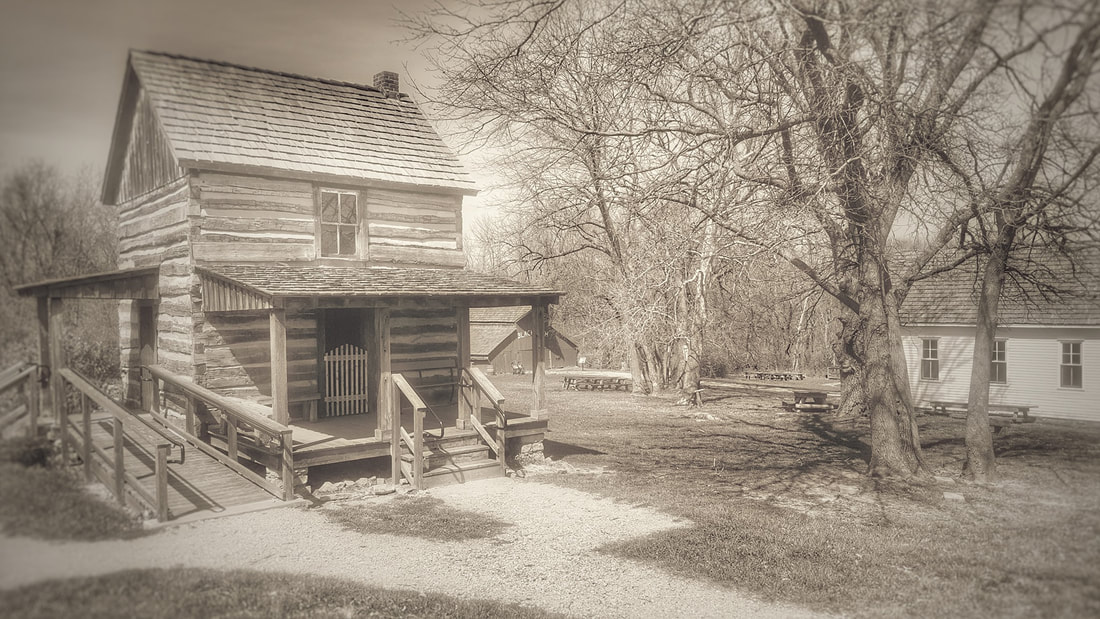
Doctor's Office 1855 - Shoal Creek Living History Museum
Originally the home of Isaac Neff and constructed sometime prior to 1855 near the community of Roosterville in Clay County, Missouri. It is currently being used as a doctor's office and home with a medicinal garden. Isaac C. Neff purchased the property in 1855 from William Tapp. There is no evidence for or against the cabin being built at that time or before. The first owner, William Tapp married Elizabeth Stollings. The Neff family owned the cabin until 1966. It was constructed just north of the community of Roosterville which is north of Liberty on A. Hwy and 112th street. Isaac just so happened to marry well. He was married to Eliza Anna Lincoln. Eliza was related to President Abraham Lincoln and in fact her father was also named Abraham.
Originally the home of Isaac Neff and constructed sometime prior to 1855 near the community of Roosterville in Clay County, Missouri. It is currently being used as a doctor's office and home with a medicinal garden. Isaac C. Neff purchased the property in 1855 from William Tapp. There is no evidence for or against the cabin being built at that time or before. The first owner, William Tapp married Elizabeth Stollings. The Neff family owned the cabin until 1966. It was constructed just north of the community of Roosterville which is north of Liberty on A. Hwy and 112th street. Isaac just so happened to marry well. He was married to Eliza Anna Lincoln. Eliza was related to President Abraham Lincoln and in fact her father was also named Abraham.
Stollings House 1885 - Struck by lightning and burned in 2017
Built in 1885 by David Y. Stollings on land South of Kearney, Missouri.
Built in 1885 by David Y. Stollings on land South of Kearney, Missouri.
Carpenter Shop / James Fox Cabin 1830s - Shoal Creek Living History Museum
Found on KCI airport property enclosed in a metal barn. Originally a single dog-trot cabin built by the James Fox family, circa 1830s, in Platte County. When the barn was dismantled, the backs of the cabins had deteriorated so much that only one cabin could be constructed from the original two. The William Fox family emigrated from Virginia to Howard County, Missouri in late 1836 and into Platte County by 1839. William's son James built this cabin near Big Branch Creek, which seems to have been renamed "Fox Creek". The original house was a dog-trot house. In the history of Platte County, Missouri James and his wife Lucinda Eskridge were charter members of Hickory Grove Union Church. When the owners of the cabin donated it to Shoal Creek, there was only enough logs to reconstruct the current main cabin.
Found on KCI airport property enclosed in a metal barn. Originally a single dog-trot cabin built by the James Fox family, circa 1830s, in Platte County. When the barn was dismantled, the backs of the cabins had deteriorated so much that only one cabin could be constructed from the original two. The William Fox family emigrated from Virginia to Howard County, Missouri in late 1836 and into Platte County by 1839. William's son James built this cabin near Big Branch Creek, which seems to have been renamed "Fox Creek". The original house was a dog-trot house. In the history of Platte County, Missouri James and his wife Lucinda Eskridge were charter members of Hickory Grove Union Church. When the owners of the cabin donated it to Shoal Creek, there was only enough logs to reconstruct the current main cabin.
Shoal Creek Restrooms
Originally a log-cabin found inside a small house located on the south side of Barry Road in Barry, Missouri. The cabin was discovered when the street was widened. It is believed to have been a community store used by settler going west.
Originally a log-cabin found inside a small house located on the south side of Barry Road in Barry, Missouri. The cabin was discovered when the street was widened. It is believed to have been a community store used by settler going west.
